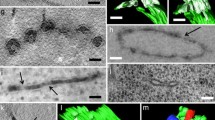Summary
The cell covering of the cryptomonadKomma caudata (Geitler) Hill is a trilaminar structure consisting of a surface periplast component (SPC) and an inner periplast component (IPC) that sandwich the plasma membrane. In order to investigate the development of the periplast, we have raised monoclonal antibodies against the cell surface ofK. caudata. Immunoblot analyses using one of these antibodies, K1/D.10, showed that it labeled a high-molecular-mass polypeptide. Immunofluorescence and pre- and post-embedding immunogold labeling studies demonstrated that the antibody recognized sites on the cell surface corresponding to the SPC plates and anotherK. caudata cell surface component, the rosulate scales. Labeling was also detected on surface domains devoid of periplast, namely the vestibular/gullet region of the cell. Post-embedding immunocytochemistry revealed that intracellular sites labeled with K1/D.10 included the Golgi apparatus and its associated vesicles. We propose that the subunits of theK. caudata cell covering are antigenically related molecules and that they self-assemble on the cell surface after secretion via the endomembrane system and deployment at the vestibular/gullet region or, in dividing cells, the cytokinetic furrow.
Similar content being viewed by others
References
Adair WS, Snell WJ (1990) TheChlamydomonas reinhardtii cell wall: structure, biochemistry, and molecular biology. In: Adair WS, Mechamand RP (eds) Organization and assembly of plant and animal extracellular matrix. Academic Press, New York, pp 15–84
—, Steinmetz SA, Mattson DM, Goodenough UW, Heuser JE (1987) Nucleated assembly ofChlamydomonas andVolvox cell walls. J Cell Biol 105: 2373–2382
Brett SJ, Perasso L, Wetherbee R (1994) Structure and assembly of the cryptomonad periplast: a review. Protoplasma 181: 106–122
Catt JW, Hills GJ, Roberts K (1978) Cell wall glycoproteins fromChlamydomonas reinhardii, and their self-assembly. Planta 138: 91–98
Ettl H, Hallmann A, Wenzl S, Sumper M (1992) A novel extensin that may organize extracellular matrix biogenesis inVolvox carteri. EMBO J 11: 2055–2062
Faust MA (1974) Structure of the periplast ofCryptomonas ovata var.palustris. J Phycol 10: 121–124
Gantt E (1971) Micromorphology of the periplast ofChroomonas (Cryptophyceae). J Phycol 7: 177–184
Harlow E., Lane D (1988) Antibodies: a laboratory manual. Cold Spring Harbor Laboratory, Cold Spring Harbor, NY
Hill DRA (1991)Chroomonas and other blue-green cryptomonads. J Phycol 27: 133–145
—, Wetherbee R (1986)Proteomonas sulcata gen. et sp. nov. (Cryptophyceae), a cryptomonad with two morphologically distinct and alternating forms. Phycologia 25: 521–543
— — (1988) The structure and taxonomy ofRhinomonas pauca gen. et sp. nov. (Cryptophyceae). Phycologia 27: 355–365
Hills GJ (1973) Cell wall assembly in vitro fromChlamydomonas reinhardii.Planta 115: 17–23
—, Phillips JM, Gay MR, Roberts K (1975) Self-assembly of a plant cell wall in vitro. J Mol Biol 96: 431–441
Jarvis MC (1992) Self-assembly of plant cell walls. Plant Cell Environ 15: 1–5
Kugrens P, Lee RE (1987) An ultrastructural survey of cryptomonad periplasts using quick-freezing freeze fracture techniques. J Phycol 23: 365–376
— — (1991) Organization of cryptomonads. In: Patterson DJ, Larsen J (eds) The biology of free-living heterotrophic flagellates. Clarendon Press, Oxford, pp 219–233 (Systematics Association special volume 45)
Laemmli EK (1970) Cleavage of structural proteins during the assembly of the head of bacteriophage T4. Nature 227: 680–685
Osborn M, Weber K (1982) Immunofluorescence and immunocytochemical procedures with affinity purified antibodies: tubulin-containing structures. Methods Cell Biol 24: 97–132
Perasso L, Hill DRA, Wetherbee R (1992) Transformation and development of the flagellar apparatus ofCryptomonas ovata (Cryptophyta) during cell division. Protoplasma 170: 53–67
—, Brett SJ, Wetherbee R (1993) Pole reversal during cell division in the Cryptophyceae. Protoplasma 174: 19–24
Roberts K, Shaw PJ, Hills GJ (1981) High-resolution electron microscopy of glycoproteins: the crystalline cell wall ofLobomonas. J Cell Sci 51: 295–321
—, Grief C, Hills GJ, Shaw PJ (1985) Cell wall glycoproteins: structure and function. J Cell Sci Suppl 2: 105–127
Shaw PJ, Hills GJ (1982) Three-dimensional structure of a cell wall glycoprotein. J Mol Biol 162: 459–471
Smith E, Roberts K, Hutchings A, Galfre G (1984) Monoclonal antibodies to the major structural glycoprotein of theChlamydomonas cell wall. Planta 161: 330–338
Spurr AR (1969) A low-density epoxy resin embedding medium for electron microscopy. J Ultrastruct Res 26: 31–43
Stuart DA, Varner JE (1980) Purification and characterization of a salt-extractable hydroxyproline-rich glycoprotein from aerated carrot discs. Plant Physiol 66: 787–792
Swords KMM, Staehelin LA (1993) Complementary immunolocalization patterns of cell wall hydroxyproline-rich glycoproteins studied with the use of carbohydrate epitopes. Plant Physiol 102: 891–901
Thompson CH, Jones SL, Whitehead RH, McKenzie IFC (1983) A human breast tissue-associated antigen detected by a monoclonal antibody. J Natl Cancer Inst 70: 409–419
Tippet DH, Pickett-Heaps JD (1977) Mitosis in the pennate diatomSurirella avails. J Cell Biol 73: 705–727
Towbin H, Staehelin T, Gordon J (1979) Electrophoretic transfer of proteins from polyacrylamide gels to nitrocellulose sheets: procedure and some applications. Proc Natl Acad Sci USA 76: 4350–4354
Wetherbee R, Hill DRA, McFadden GI (1986) Periplast structure of the cryptomonad flagellateHemiselmis brunnescens. Protoplasma 131: 11–22
— —, Brett SJ (1987) The structure of the periplast components and their association with the plasma membrane in a cryptomonad flagellate. Can J Bot 65: 1019–1026
Zola H (1987) Monoclonal antibodies: a manual of techniques. CRC Press, Boca Raton
Author information
Authors and Affiliations
Rights and permissions
About this article
Cite this article
Perasso, L., Ludwig, M. & Wetherbee, R. The surface periplast component of the protistKomma caudata (Cryptophyceae) self-assembles from a secreted high-molecular-mass polypeptide. Protoplasma 200, 186–197 (1997). https://doi.org/10.1007/BF01283294
Received:
Accepted:
Issue Date:
DOI: https://doi.org/10.1007/BF01283294




